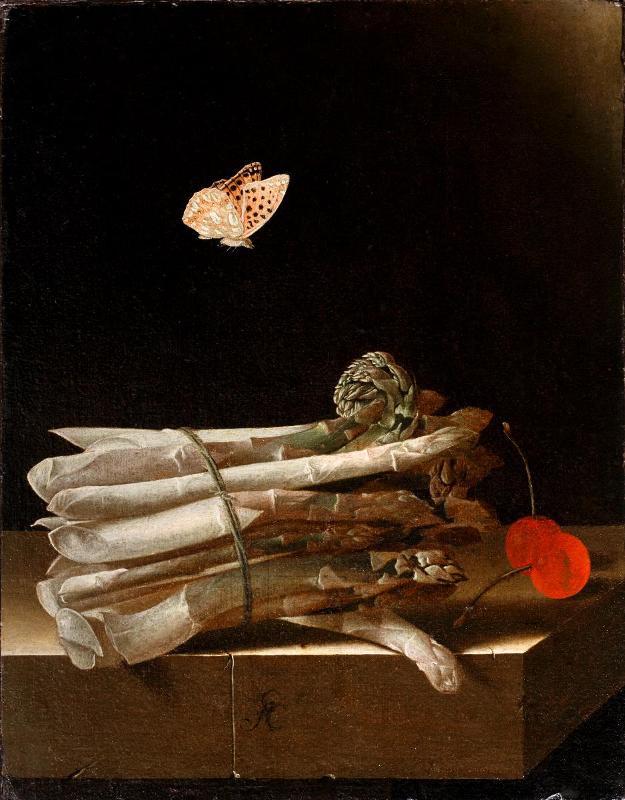
❖❖❖
THIS WEEK
JAMES BOND'S TASTES
THE MAN WITH THE GOLDEN GUN
By John Mariani
NEW YORK CORNER
LA PULPERIA
By John Mariani
GOING AFTER HARRY LIME
CHAPTER FIFTEEN
By John Mariani
NOTES FROM THE WINE CELLAR
MORE BANG FOR THE BUCK
By John Mariani
 Judy
Carmichael. Go to: WVOX.com.
The episode will also be archived at: almostgolden.
Judy
Carmichael. Go to: WVOX.com.
The episode will also be archived at: almostgolden.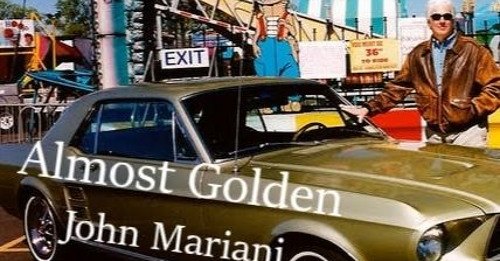
❖❖❖
JAMES
BOND'S TASTES:
THE MAN WITH THE GOLDEN GUN
By John Mariani

The
Man with the Golden Gun
(1965) was Ian Fleming’s twelfth and last Bond
novel (published posthumously), and it was
fairly limp (and poorly reviewed) by
comparison to its antecedent, You Only
Live Twice, in whose ending the British
spy was r ecovering in Japan
from amnesia and needed to go to Russia to jog
his memory. The Man with Golden
Gun slides over whatever happened there,
opening with the news that MI6 presumed 007
dead for more than a year, only to find him
return so brainwashed by the Russians that he
tries to assassinate his boss M with a cyanide
pistol.
ecovering in Japan
from amnesia and needed to go to Russia to jog
his memory. The Man with Golden
Gun slides over whatever happened there,
opening with the news that MI6 presumed 007
dead for more than a year, only to find him
return so brainwashed by the Russians that he
tries to assassinate his boss M with a cyanide
pistol.
After being “de-brainwashed,” Bond is
back on the job, sent to Jamaica (a frequent
Fleming location) to kill Francisco “Pistols”
Scaramanga, a paid assassin of several British
agents. He is known as "The Man with the Golden
Gun" because his preferred weapon was a
gold-plated Colt .45 revolver with solid-gold
bullets.
Bond is said to be still drinking too
much, but there are few references to his
appetites in the book; he still favors bourbon
over Scotch and Champagne over all. M, over
lunch at his club Blades, orders an Algerian
wine called Infuriator, which Bond loathes.
Scaramanga prefers Jamaican Red Stripe
beer.
prefers Jamaican Red Stripe
beer.
Bond masquerades as Scaramanga’s personal
assistant at his bordello in the Thunderbird
Hotel, where 007 is welcomed with a meal of eggs
Benedict and a bottle of Walker’s Deluxe
bourbon. Bond learns that Scaramanga is involved
with a syndicate of American gangsters and KGB
agents. Not much of a world-shattering threat
here: Scaramanga and his investors want to
increase the value of the Cuban sugar crop, run
drugs and prostitutes into the U.S.
Over lunch with Scaramanga, Bond orders
Beefeater’s pink gin with “plenty of bitters” to
go with shrimp cocktail, steak and French fries.
 Bond meets up
with his CIA friend Felix Leiter, pretending to
be an electrical engineer in Scaramanga's
meeting room, where Leiter learns that
Scaramanga plans to kill Bond. At dinner in the
hotel dining room, the meal consists of “desiccated
smoked salmon with a thimbleful of small-grained
black caviar, filets of some unnamed native fish
(possibly silk fish) in a cream sauce. A ‛poulet
suprême’ . .
. and the bombe surprise.”
Bond meets up
with his CIA friend Felix Leiter, pretending to
be an electrical engineer in Scaramanga's
meeting room, where Leiter learns that
Scaramanga plans to kill Bond. At dinner in the
hotel dining room, the meal consists of “desiccated
smoked salmon with a thimbleful of small-grained
black caviar, filets of some unnamed native fish
(possibly silk fish) in a cream sauce. A ‛poulet
suprême’ . .
. and the bombe surprise.”
After a KGB agent exposes them, Leiter
and 007 manage to kill many of the bad guys and
hop aboard Scaramanga’s train, where Bond, even
during a gunfight, fantasizes about a meal of
cold lobster salad, cold cut meats, pineapple
and local fruit, roasted in a stuffed suckling
pig with rice and peas, and champagne, rum punch
and Tom Collins cocktails. Both Bond and
Scaramanga are wounded, and Scaramanga limps off
into the swamps. When Bond finds him, he is
eating a boa constrictor and drinking its blood,
offering some to Bond, who replies, “No thanks.
I prefer my snake grilled with hot butter
sauce.”
The villain offers Bond
money—he refuses—and asks Bond not to kill him
in cold blood and to allow him a moment to
pray—“I’m a Catholic!” he declares—but then
pulls out a golden derringer with a snake venom
bullet and shoots Bond, who returns fire, kills
his foe, then collapses in pain.
It
takes weeks for Bond to recover fully, and then
M offers him a knighthood, which 007 mulls over,
saying it makes him shudder at the thought of
being called Sir James Bond. 
The
1974 film made from The Man
with the Golden Gun was
the ninth, and Roger Moore’s second appearance
as the British agent. The plot had nothing to do
with the book’s, as became the standard practice
in subsequent Bond films. There is little
reference to food and drink, though right at the
movie’s beginning Scaramanga’s midget
assistant/henchman Nick Nack (Hervé Villechaize)
brings a tray of Moët Champagne and a bottle of
Guinness Stout with oysters to Scaramanga
(Christopher Lee) and his moll, Andrea Anders
(Maud Adams).
Bond is sent to find
Scaramanga (who is known to have a third nipple)
after MI6 receives a golden bullet etched with
“007” on it. Bond retrieves another golden
bullet from a belly dancer’s navel. (She, too,
is partial to Moët; Bond orders Dom Pérignon at
his hotel; both are Moët brands, which tells you
something about product placement). The bullet
is traced to a gun maker in Macau.
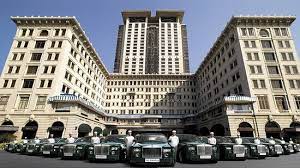 Accompanied
by Andrea, Bond goes to Hong Kong and checks
into the Peninsular Hotel (left), then
goes to the Bottoms Up Club, where Nick Nack
steals a high energy device called the Solex
Agitator. Bond is arrested for pulling his own
gun outside the club, but the Hong Kong police,
led by Lieutenant Hip, bring him to meet M and Q
onboard the RMS Queen
Elizabeth, which, after
a fire in 1972 capsized and
Accompanied
by Andrea, Bond goes to Hong Kong and checks
into the Peninsular Hotel (left), then
goes to the Bottoms Up Club, where Nick Nack
steals a high energy device called the Solex
Agitator. Bond is arrested for pulling his own
gun outside the club, but the Hong Kong police,
led by Lieutenant Hip, bring him to meet M and Q
onboard the RMS Queen
Elizabeth, which, after
a fire in 1972 capsized and  was left
rotting in the Kowloon harbor. There he is
ordered to retrieve the Solex Agitator.
was left
rotting in the Kowloon harbor. There he is
ordered to retrieve the Solex Agitator.
Posing
as Scaramanga (complete with fake nipple), Bond
flies to Bangkok to meet entrepreneur Hai Fat,
who had the scientist who created the Solex
killed. Bond’s plan fails when Scaramanga
himself is found to be operating at Fat's estate
at Dragon Garden, Castle Peak Road, Castle Peak.
Bond is then captured and sent to a martial
arts academy at Muang Boran, where students are
instructed to kill him. Bond
fights two of them and is then
rescued by Hip and two teenage girls trained in
martial arts.
and is then
rescued by Hip and two teenage girls trained in
martial arts.
Fat’s
men follow Bond, who escapes on a motorized sampan
on Bangkok’s canal system. He reunites with his
assistant Mary Goodnight, with whom he has a
dinner at the Oriental Hotel, where the waiter
offers them a bottle of Phuyuck ’74 (the same
year as the movie) wine.
Scaramanga
kills Fat and obtains the Solex. Anders begs
Bond to kill Scaramanga, and promises to get the
Solex, but she is murdered at a Muay Thai boxing
event at the Lumpini Stadium the next day. Bond
does obtain the Solex with the help of
Goodnight, who is kidnapped by Nick Nack, with
Bond in pursuit, not, however, in his usual
Aston Martin but instead in a borrowed AMC
Hornet.
the help of
Goodnight, who is kidnapped by Nick Nack, with
Bond in pursuit, not, however, in his usual
Aston Martin but instead in a borrowed AMC
Hornet.
Bond takes a seaplane to Scaramanga's private
island at Phang Nga Bay, where Nick Nack
receives him with a bottle of Dom Pérignon ‘64
(Bond says he prefers the ’62). Scaramanga
destroys Bond’s plane with his Solex laser, 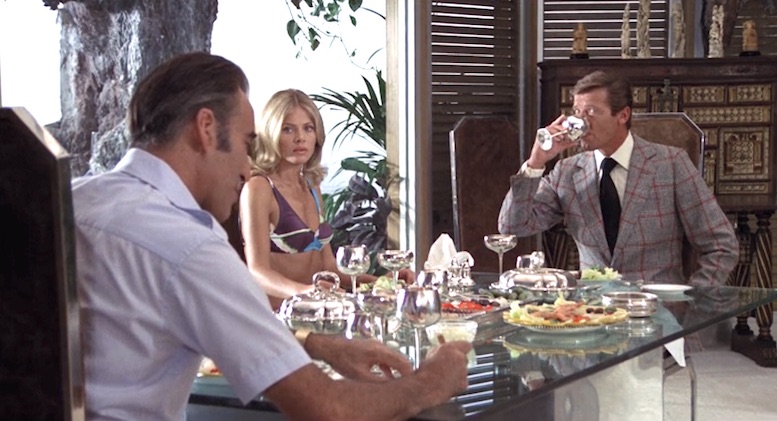 then,
over a lunch of mushrooms and other delicacies,
Bond comments on his host’s choice of wine,
“Hmm, slightly reminiscent of the ’34 Mouton.” Scaramanga
says “I must get some for my cellar.”
then,
over a lunch of mushrooms and other delicacies,
Bond comments on his host’s choice of wine,
“Hmm, slightly reminiscent of the ’34 Mouton.” Scaramanga
says “I must get some for my cellar.”
He then proposes a duel on
the beach. After pacing off, 007 finds
Scaramanga has vanished. Nick Nack leads Bond
back to  Scaramanga’s house,
which has a fun house of mirrors and diversions.
Bond manages to kill Scaramanga and retrieve the
Solex, blowing up the island and taking his
foe’s Chinese junk to escape with Goodnight for
an eight-hour sail to Hong Kong.
Scaramanga’s house,
which has a fun house of mirrors and diversions.
Bond manages to kill Scaramanga and retrieve the
Solex, blowing up the island and taking his
foe’s Chinese junk to escape with Goodnight for
an eight-hour sail to Hong Kong.
NEW YORK CORNER
LA PULPERIA
623 Ninth Avenue
646-669-8984
.jpg)
No one is sure how Hell’s Kitchen, the
neighborhood bound by the Hudson River on the
west, 30th Street on the south and 59th Street
on the north, got its name. Some say it’s a
tangling of the name of a 19th century German
restaurant, Heil’s Kitchen, others because of
its disrepute as a crime-ridden area. Yet, even
though real estate developers dub it “Clinton,”
no New Yorker uses that name.
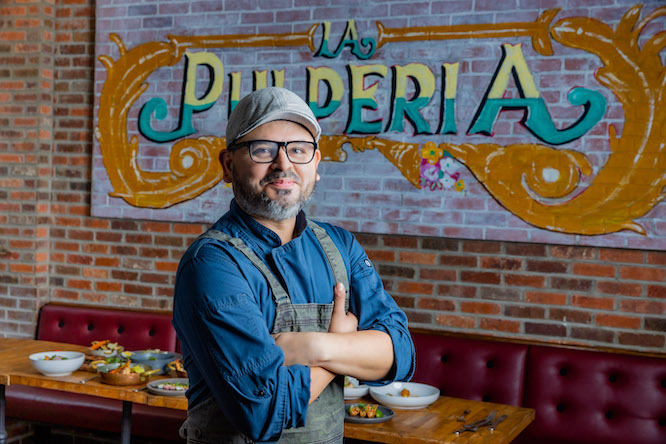 Whatever its
origins, Hell’s Kitchen has long been a section
teeming with restaurants of every stripe, not
least the Jewish delis of the Garment District.
These days it is more diverse than ever, with a
slew of new Latin American restaurants that add
measurably to the area’s gastronomic clout.
Whatever its
origins, Hell’s Kitchen has long been a section
teeming with restaurants of every stripe, not
least the Jewish delis of the Garment District.
These days it is more diverse than ever, with a
slew of new Latin American restaurants that add
measurably to the area’s gastronomic clout.
La Pulperia is very much one of those
showcasing a panoply of regional cuisines, based
on the creativity of Executive Chef Miguel Molina,
who hails from Guerrero, on Mexico’s
west coast. He arrived in New York in 1996 and
worked in French and Italian restaurants
throughout Manhattan and Brooklyn, and now creates
his own ideas from a long career that began on his
parent’s farm restaurant.
The interior of La Pulperia has a maritime
motif throughout, but I wish that the designer,
Andres Gomez, had put more thought into the
acoustics, for this is a very loud restaurant with
booming music, whose 88 decibels equate to the
sound of a bulldozer coming through the room. I
happened to be dining with an interior designer,
who said the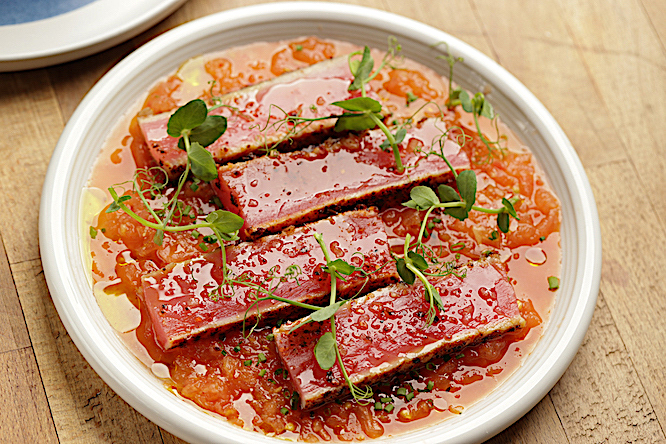 room had not a single soft, sound-absorbing
surface or anti-buffering components that would
lessen the noise and heighten the joviality of the
place.
room had not a single soft, sound-absorbing
surface or anti-buffering components that would
lessen the noise and heighten the joviality of the
place.
That said, the food is terrific. Tuna con
Tomate (right) is a twist on the
simpler, traditional pan con
tomate found in Spain; pan-seared tuna is
sliced thin and placed on toast with a spicy salsa
made of grated heirloom tomato, lemon zest,
garlic, parsley, chives and aleppo
peppers ($20). Croquetas de
Bacalao stay more traditional and are
wonderful to bite into as long as you know they
are piping hot, filled with salted cod and served
with citrus aïoli ($15). 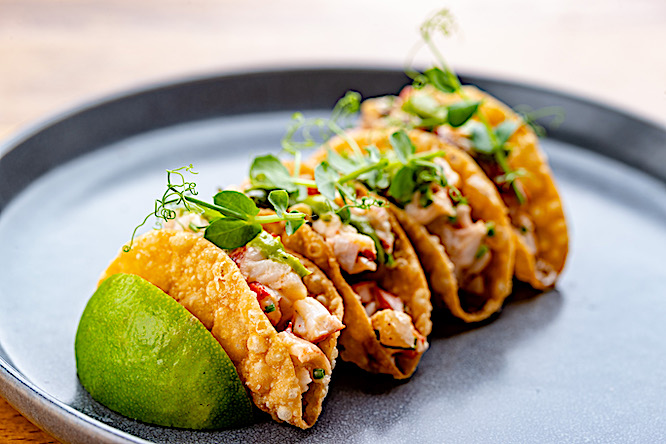 Smoky
sun-dried tomato tapenade is the base for a
yellowtail hamachi tostada,
with avocado, jalapeños, and radishes, topped with
crispy fried leeks and ancho chile powder ($20).
Smoky
sun-dried tomato tapenade is the base for a
yellowtail hamachi tostada,
with avocado, jalapeños, and radishes, topped with
crispy fried leeks and ancho chile powder ($20).
The
ceviches are glistening fresh, and the mixto ($19)
is the best way to sample the range, as a cocktail
made with shrimp, white fish, squid, jalapeño, red
onions, cilantro and avocado. Parsnips add a sweet
flavor to grilled octopus, along with a dash of
white truffle oil, shaved fennel and caramelized
onion (($27).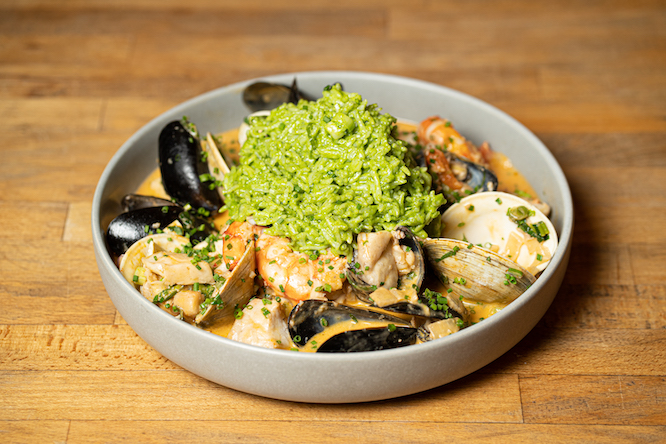
Another mixto of seafood (right),
cooked as a main course and intended for two or
more, is a Brazilian favorite composed of abundant
squid, langoustine, mussels, white fish, scallops,
clams, cod and peppery Spanish chorizo in a
dandelion-based broth, topped with green
coconut-cilantro rice ($38). Argentina adds to the
menu with a huge parrillada
(priced for two at $110, but it can feed three or four
handily) of New York strip sirloin, skirt steak,
short ribs, chicken, chorizo, morcilla,
salsa criolla, papas à la Provençal, and a
green salad spiked with 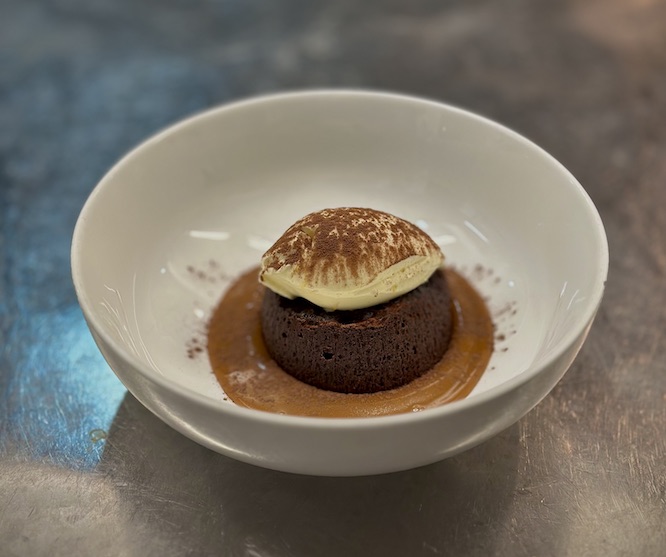 chimichurri.
The
simplest entrée is the day’s whole fish, expertly
deboned (market price).
chimichurri.
The
simplest entrée is the day’s whole fish, expertly
deboned (market price).
Desserts ($12) include a “Volcano
Chocolate” lava cake exuding dulce de leche,
topped with orange mascarpone cream. I can never
refuse hot, fried churros
fritters, which are eaten throughout the day in
Spain, and are served with a rich, warm dulce de
leche.
You’d expect an array of fanciful cocktails
and won’t be disappointed, along with both white
and red sangria. They also stock dozens of
tequilas and mezcals that would take weeks to go
through.
La Pulperia is one of those New York Latino
restaurants that show a range of foods
and ingredients you’d have to travel throughout
Central and South America to find with such
radiance and creativity.
Open for dinner nightly; brunch
Sat. & Sun.
GOING AFTER HARRY LIME
By John Mariani
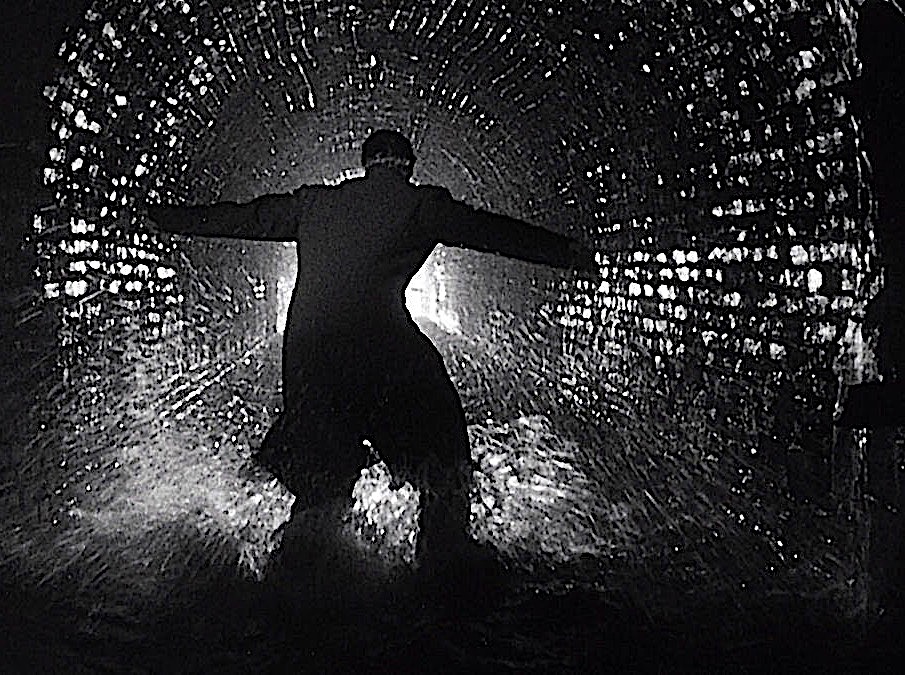
CHAPTER FIFTEEN
Joseph
Southey called Leonid Lentov to ask if
he’d see the two Americans and was not surprised
when the Russian said he would be very happy to
do so. David
followed up and was equally surprised when
Lentov did not even ask why David was calling,
saying only, “Yes, yes, Southey told me about
you. Come over whenever you want. I may have
some good stories for you.”
As a detective David was always
suspicious of people who too readily volunteered
information, not least those who might have
something to gain from being so readily open to
questions. He also knew not to trust everything
any spy would tell him because such people were
trained liars, and often intertwined fact and
fiction after many re-tellings of so many “good
stories” that the truth was often no more than a
kernel in a rotted-out cob of fictions.
Still, David was one of the best at
clearing away the outright fabrications of
informers and cutting closer to what probably
happened. David knew that the more a person
spoke voluntarily the more likely he was to
provide good leads while trying to embellish his
own importance. The more they gave an
interrogator, the more informers believed they
would be believed. But with spies—and David had
no particular experience interrogating them—the
game was different. Agents—especially double
agents--were trained to undergo interrogation,
even torture, knowing full well that they only
needed to hold up as long as it seemed plausible
that they could stand no more pain. Of course,
the interrogators were well aware of this, too,
which made the whole thing of questionable
value. And
the informers always had good stories set to be
told, some actually the truth, some even
exposing their colleagues to danger, just enough
to make them sound cooperative. It was all part
of the training.
 David was well
familiar with such tactics, but he always asked
himself, what’s in all this for the person under
scrutiny? Is he really giving up under duress?
Or is he begging for mercy in order to spread
dis-information? Or does he really want to get
free of his criminal past and gain protection
from the interrogators? It
could be a combination of all of those reasons,
but saving one’s dignity never had anything to
do with any of them. Sometimes money did.
David was well
familiar with such tactics, but he always asked
himself, what’s in all this for the person under
scrutiny? Is he really giving up under duress?
Or is he begging for mercy in order to spread
dis-information? Or does he really want to get
free of his criminal past and gain protection
from the interrogators? It
could be a combination of all of those reasons,
but saving one’s dignity never had anything to
do with any of them. Sometimes money did.
In the case of Leonid Lentov there was no
question of offering him money, first, because
there was no money to offer and, second, unlike
in police dealings with criminals, bribery was
completely forbidden under the journalistic code
Katie lived by. The most she could do was buy a
source a meal or a few drinks. Money
was never promised or passed in an envelope.
Lentov didn’t sound like he expected any.
Southall (above) was a suburban
part of London not in line for gentrification.
It was poor, with a large enough complement of
Indians to earn the nickname “Little India.” For
that reason, the storefronts were crucibles of
aromas floating out into the street air—scents
of cumin, fenugreek, cardamon, roasted peanuts
and sesame seeds, the same smells David
remembered from the Indian restaurant he’d eaten
at on Brompton Road. The grocery store signs
were written in Punjabi, the DVD stores were
plastered with posters of Bollywood stars, and a
pub called The Glassy Junction  even
accepted rupees.
even
accepted rupees.
In every
way the settling of Leonid Lentov in Southall
was a form of secluded banishment by MI6. For,
although he was in no danger of being
assassinated by the Soviets, shunting him out of
the center of London was both prudent and a
deliberate snub to a man for whom MI6 had no
further use, much as the KGB did with Kim
Philby. Out of sight and mind.
There was no tube station at Southall, so
Katie and David took a train out of Paddington
Station, a fifteen-minute ride, arriving at a
small brick-clad station with bilingual signs in
English and Punjabi. Lentov’s flat was about
five blocks away, but he’d asked the two
Americans to meet him at The Glassy Junction on
South Road.
The pub was in a nondescript three-story
building topped with a sign saying GLASSY
JUNCTION in English and a larger-than-life
cut-out of a mustachioed, turbaned Sikh above
the entrance. Katie and David went inside to
find the pub looked like so many others, except
there was a Sikh behind the bar, a painting of
cows above the bar and Indian pop music playing.
From a rear corner table a large man was
gesturing to them to come over. Though bearded,
the man was clearly not a Sikh.
“Welcome!” the man said in a booming,
accented voice. “I am Leonid Lentov, and you
must be the Americans who called me.”
Katie and David introduced themselves and
sat down in the booth where Lentov had been
drinking a pint of ale. He got up to greet them,
six feet-four inches of him, with a beard
somewhere between Rasputin’s and Andrei
Solzhenitsyn’s in length, gray and unkempt, as
was his rough tweed jacket. Lentov’s
face, however, showed no trace of peasant blood:
Very handsome, with high cheek bones, thick
black brows and eyes that had the glint of a fox
rather than a wolf in them, as if you had to pay
strict attention to see if they ever blinked. It
also seemed clear to Katie and David that
alcohol had worked its way deep into his
demeanor and physical appearance. A
century before he might have been White Russian
but he was born under the U.S.S.R. and grew up a
good Communist.
“So
how do you know my friend Southey?” he asked,
signaling the bartender to bring two more ales.
David explained how they’d come to meet
Southey through Frank English, and how Southey
had said Lentov would be a good source for
Katie’s story.
“So you are a journalist,” he said as a
statement to Katie, “and you, sir, are an ex-New
York City policeman?”
“I was chief detective investigating mob
activities there, yes.”
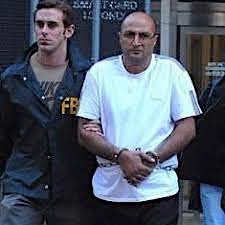 “Italian Mafia, correct?” Lentov’s
English was excellent—he had been in the
diplomatic corps—with just a slight rolling of
his r’s and hard s’s. “Pretty
soon
you won’t have to worry about them in New York
anymore. The Russian Mafia will push them out.
Armenians and Albanians, too. They are the worst
of all. Kill their own brother for nothing.”
“Italian Mafia, correct?” Lentov’s
English was excellent—he had been in the
diplomatic corps—with just a slight rolling of
his r’s and hard s’s. “Pretty
soon
you won’t have to worry about them in New York
anymore. The Russian Mafia will push them out.
Armenians and Albanians, too. They are the worst
of all. Kill their own brother for nothing.”
David needed to save face, saying, “Oh,
yeah, they were in my sights, too.” 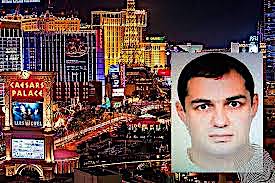 He then rattled off the names of some of
the eastern European gang leaders. “Armen
Kazarian (left), Razhden Shulaya (right),
a lot of other creeps. I retired a few years
ago, so I haven’t kept in touch.”
He then rattled off the names of some of
the eastern European gang leaders. “Armen
Kazarian (left), Razhden Shulaya (right),
a lot of other creeps. I retired a few years
ago, so I haven’t kept in touch.”
Lentov smiled and leaned back on the
tufted banquette. “So, what do you want to know?
About Graham Greene? I knew him a little.
Burgess and MacLean? I was just entering service
when they escaped. Philby, him I knew well.”
Katie and David had discussed beforehand
that they would allow Lentov to tell his own
story before getting into the one they were
pursuing. David suspected that this was not
Lentov’s first drink of the day and that the
Russian would be more forthcoming as the
afternoon went on. David paid for Katie’s and
his ales and gave the bartender a fifty-pound
note, indicating he should keep the pints
coming. Katie was supposed to charm Lentov
before asking the questions she needed answers
to.
“Just to fill in some background, Mr.
Lentov,” she said, “I’d like to know more about
your own career and how you got to this point in
your life.”
Lentov finished his glass and called for
another. “Beware such questions—may I call you
Katie?—because Russians like nothing more than
talking about themselves, especially when their
lives were, shall we say, put in jeopardy. We
all grow up believing we are guilty of
something.”
“We have all day,” said Katie, thinking
that her own Catholic upbringing had instilled
the same feelings of guilt.
 And so for the next
hour and a half Leonid Lentov spoke of his life,
one that had come to a dead end too early,
especially after enjoying the perks of being in
the Soviet diplomatic corps in London after the
war, where he'd lived off and on in the 19th century
Victorian mansion, in Kensington Palace
Gardens, the largest building on the street (left).
And so for the next
hour and a half Leonid Lentov spoke of his life,
one that had come to a dead end too early,
especially after enjoying the perks of being in
the Soviet diplomatic corps in London after the
war, where he'd lived off and on in the 19th century
Victorian mansion, in Kensington Palace
Gardens, the largest building on the street (left).
In
so many ways Lentov seemed destined for the kind
of life most Russian could barely dream of. His
family had, indeed, been white Russians—the name
given to those who opposed the Communists during
the Civil War—but bribery had brought them
through the worst of it, and Lentov’s father,
who spoke perfect French and English, worked his
way up into the diplomatic corps, where his son
Leonid was expected to follow. Highly
intelligent and ambitious, Leonid Lentov rose
quickly within the Soviet system, even as he
clung to the idea that he was superior to all
his communist superiors.
Another round of drinks arrived.
“I knew that eventually I would be tapped
by the K.G.B. to work as an agent in London,” he
said. “Everyone was. It was no secret. The
British knew we were all spies to one degree or
another, and we knew that many of our opposites
in Moscow were MI6. It was all a game. Very few
people got hurt.”
“So, you mean, if you or your opposite
were discovered to be a spy, you wouldn’t be
executed?” asked Katie.
Lentov laughed. “Of course not! We were
too valuable alive. That’s why it was such a
tremendous shock and embarrassment for the Brits
to lose not just Burgess and MacLean but also
their handler, Kim Philby. It was a farce and
many heads rolled at MI6—figuratively speaking,
of course.
The only time anyone was executed was if
one of your own people was found to be a double
agent, like those three were. They all would
have hanged if they’d been arrested.”
“So catching you was something of a coup,
then,” said David, using a slight bit of
flattery.
Lentov shrugged. “I was not a big fish.
But I would rather have stayed in London once I
was found out than go back to Moscow, where I
would be living like a peasant for the rest of
my life.”
Lentov looked around the pub and said,
“Of course, living the way I do out here is not
what I expected, but it’s a much better life
than I would have had in Moscow, or wherever the
Soviets would have sent me.”
“So, you were offered a deal by British
Intelligence,” said Katie.
Lentov nodded and said, “It was probably
time for me to jump anyway. By the 1980s I’d
become completely disillusioned with the
Communist ideologues running my
country—Brezhnev, Andropov, Chernenko. Philby
would rage at the TV every time Brezhnev (right)
would come on. Men of no intelligence, mere
bureaucrats with no idea of what was going on in
the rest of the world. Gorbachev did, of course,
but by then I was working for MI6 as a double
agent.”
Lentov described how the Brits had shoved
him into a car, brought him to MI6 and
confronted him with the evidence that he had
been responsible for the arrest of two of their
agents in East Germany and threatened him with a
life sentence in prison if he did not cooperate.
“The choice was easy,” said Lentov. “I
was getting older, I enjoyed my life here in
London, had no family, and came and went pretty
much as I wished. My spying for the Soviets
rarely involved anything as important as my
exposing those two British agents—for which I
was highly praised by Moscow but got nothing
from it—and the Brits were only asking me to
stay put in the Soviet Embassy here and feed
them information.”
The arrangement didn’t
last long. After three years Lentov was due to
be re-assigned to a post in Pakistan he had no
interest in taking.
“I’m sure the Soviets were on to me by
then,” he said, “so I told my MI6 handlers the
game was over.
And here I am, living in Southall,
drinking in an Indian pub, telling my sad story
to two Americans.” He raised his glass and
toasted in Russian, “Nasdrovia!”
Although David was well familiar with why
turn-coats—whether against the crime mobs or
intelligence agencies—were spared assassination,
though it was not clear to Katie.
“So you never felt you had to look over
your shoulder after the Soviets found out about
you?” she asked.
Lentov chuckled. “Thank
you for your concern, Katie, but in my line of
work, I was always looking over my shoulder.
Now, like so many other former spies, I am a
toothless dog. I know nothing, I have access to
nothing, and, like Kim Philby, I am worth
nothing to anyone. And the Cold War is long
over. We are all good friends now, correct?”
That was Katie’s opening to begin her
line of questioning about Philby, or anyone else
that Graham Greene might have known in the
K.G.B. right after the war.
“Well, then,” she began. “As someone who
was in London all that time and knew all the
agents and double agents, as well as Philby and
Graham Greene, can you throw any light on what
I’m looking for? I assume you’ve seen the film The
Third Man?”
It was clear that the alcohol was having
little effect on Lentov but he seemed very happy
to tell Katie and David whatever they wanted to
know—although David suspected Lentov might also
tell them a lot of what he thought they’d want
to hear.
“The movie was very close to the way
things operated after the war,” said Lentov.
“Greene had been in MI6, you know, so he got the
details right.”
“Would that include criminal activities
like selling bad penicillin on the black
market?” asked David.
“Very probably,” Lentov answered. “But
that would be what you call chicken feed
compared to other drugs.”
“And so you think Greene would have been
right to think the Soviets would provide a safe
refuge for Harry Lime in their sector?”
“Absolutely! As they say in the movie,
everyone in Vienna was involved in the black
market, but the Soviets had the means and power
to make it flourish and to take their unfair
share of the profits.”
“So, in effect,” said Katie, “Harry Lime
was working with and for the Russians.”
Lentov nodded and said, “But let’s
remember that Lime was a fictional character,
Katie. But, if he did exist, yes, the Russians
would in all likelihood be his benefactors. They
would take their cut, yes.”
“So,” Katie asked slowly, “do you think
Greene based Lime on anyone he knew in Vienna?
Could it have been Kim Philby?”
Lentov reminded the Americans that Philby
was not known to have been anywhere near Vienna
in those days, and, he said, “It’s difficult for
me to believe that he could be acting as a
double agent somewhere else and still have time
to run a drug operation in Vienna.”
“True,” said David, “but we’re not
looking for an exact identification with Lime.
If Greene already knew—or even suspected—that
Philby was a double agent while continuing to
befriend Greene, do you think it possible that
it could have been the case that Philby was
involved as well in the black market in Vienna,
or anywhere else in Europe, after the war.”
Lentov sat back, breathed deeply, looked
at his watch, then called for another pint.
“Let me tell what I know of Philby,
before and after his escape from Beirut,” said
Lentov. “You know, before I was outed as a spy,
I could travel back and forth to Moscow and,
since I’d known him in London, I was able to
visit him at his flat. I found him almost as
fascinating as Greene did, but Philby and I both
used Greene as a mouthpiece. He was such a
gullible man. When Greene died, I felt rather
sorry for him.”
Lentov went on to describe Philby as a
master of disguise—not make-up and wigs, but in
changing his physicality to put a person at ease
upon meeting them while at the same time
impressing them with his personal charisma.
Philby was handsome, well read, well traveled,
and, among his colleagues at MI6, deeply
respected for his insight. How many times had he
saved comrades’ lives by his ingenuity, getting
them out of harm’s way with uncanny precision—as
he had with Burgess and MacLean! How fine a
family man he was when he married for the second
time and fathered five children! A drinker who
never seemed to get drunk! A man who could speak
with authority on the best hotels, the best
hunting rifles, the best coffee in Venice, the
finest restaurant in Istanbul! Yes, were a
novelist to choose the ideal British spy, Kim
Philby would have been ideal.
“Philby’s greatest gift was to appear to
be your very good friend,” said Lentov. “ I
thought he was to me. Even after I became his
opposite—a Russian who spied for the British—we
had a marvelous relationship. It’s not all that
unusual among retired spies, you know. Rather
like RAF pilots buying drinks for Luftwaffe
pilots they shot down in the war and vice versa.
Philby never accused me being a turncoat. He
knew how the game worked. Mostly we just talked
about the old days. Of course, his old days were
far more exotic than mine.”
Katie interrupted, “Is it true that—at
least from all I’ve read and gotten from
others—that, although he insisted he never gave
up his ideals about communism, he was a very
sad, disillusioned man at the end of his life.”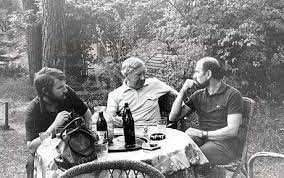
Lentov shook his head and said, “Philby
ended up like me. His ideals? I don’t know. His
benefactors at the K.G.B. certainly did not
treat him the way he had hoped. He became a
heavy drinker.”
Lentov told of how Philby had expected
full military honors on his return to Moscow,
and perhaps a position high in the senior
rankings of the K.G.B. Instead
he was ignored, and, with his third wife—a
Russian twenty years his junior—he lived in a
small, dreary flat near Pushkin Square, with
little or no access to the outside world except
via mail—all of which was censored, coming in
and going out, including Graham Greene’s many
letters. The K.G.B. told Philby
they had information that MI6 was going to try
to assassinate him, so he needed full-time
guards to protect him.
When visitors—Lentov excepted—sought to
visit Philby, they would be met at the Moscow
airport and put in a taxi whose driver pulled a
curtain and was not allowed to speak except by a
car phone with authorities. At
Philby’s address, the visitor was greeted by a
K.G.B. agent and escorted upstairs to the flat. At an
exact, pre-appointed time, the visitor was
required to leave, first frisked to see if
Philby had given the visitor something to get
out of the country.
“I saw him perhaps six times in all those
years before I myself was moved out here to
Southall,” said Lentov. “Then I was allowed no
contact with him whatsoever. Greene
might have before he died.”
Katie and David seemed drained by
everything Lentov had told them. Katie even felt
a little sorry for Philby, while David knew that
was part of Lentov’s intent. Yet, despite it
all, they were still no closer to Harry Lime
than before.
Katie thanked Lentov for everything he’d
shared with them, then said, “Well, I suppose
this is still very much a mystery. If only we
could actually talk to Kim Philby, have him shed
light on it all.”
“Well,” said Lentov, “that would be very
difficult to arrange.”
“Especially since Philby’s dead,” said
David.
Lentov smiled, paused, then
said, “Oh, Philby’s not dead.”
© John Mariani, 2016
❖❖❖
MORE BANG FOR THE BUCK
By John Mariani
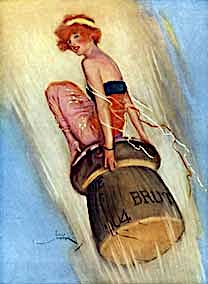 Given their rarity—usually by
design—great wines are made to be expensive: the
2019 DRC’s Romanée-Conti is currently selling at
$34,000, and it’s nowhere close to being ready to
drink. But there are also too many wines whose
makers think they should be getting prices above
$100 a bottle merely on chutzpah. More sensible
vintners know they will sell more good wine when
it’s priced more amenably. Here are several that
make very good sense and are worth every penny.
Given their rarity—usually by
design—great wines are made to be expensive: the
2019 DRC’s Romanée-Conti is currently selling at
$34,000, and it’s nowhere close to being ready to
drink. But there are also too many wines whose
makers think they should be getting prices above
$100 a bottle merely on chutzpah. More sensible
vintners know they will sell more good wine when
it’s priced more amenably. Here are several that
make very good sense and are worth every penny.
FULLDRAW FD2 2018
($55)—This young Paso Robles Willow Creek District
AVA owned by Connor and Rebecca McMahon produces
Rhône varietals, like this well fruited Grenache and
Syrah. This is a boutique winery founded ten years
ago on a 100-acre site with rich limestone that
provides their wines 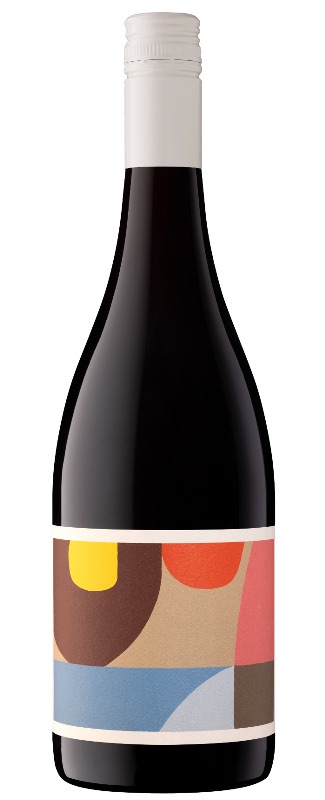 with a brisk minerality. The price
is just right for this caliber of Rhône Ranger,
which are too often big bombs of little finesse.
with a brisk minerality. The price
is just right for this caliber of Rhône Ranger,
which are too often big bombs of little finesse.
ALKINA KIN SHIRAZ 2021 ($36)—
FEL
WINE ANDERSON VALLEY CHARDONNAY 2021 ($34)—I am
among many who have long criticized so many
California Chardonnays for tasting like candy-coated
charred oak, but FEL enjoys the Anderson Valley cool
climate to produce far more balanced wines sourced
from Ferrington Vineyard.
This Chard spends a long 10 months sur lie
aging and fermenting in neutral French oak.
Director of Winemaking Ryan Hodgins and winemaker
Sarah Green insist on a "hands off" approach in
the cellar, so the wine does not taste manipulated
to taste a particular way, letting Nature takes
its course instead.
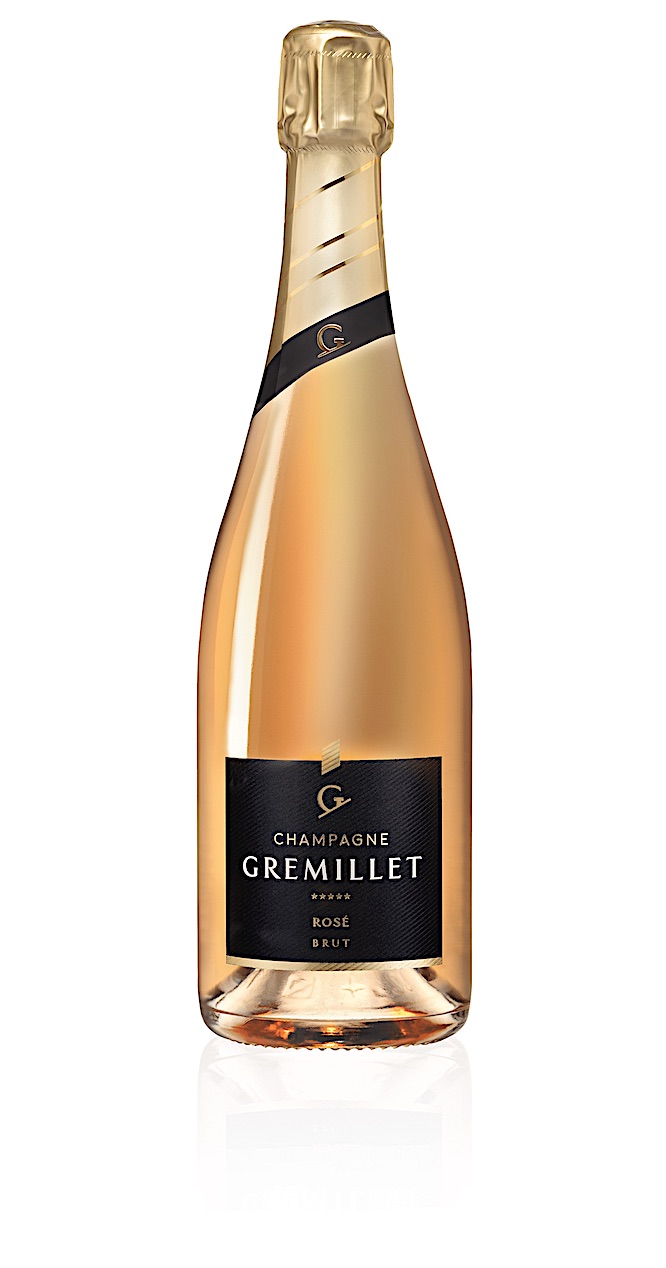 CHAMPAGNE
GREMILLET ($40)—In the rarified culture of
Champagne, where houses measure their esteem by
centuries, Gremillet,
in Aube, is a late bloomer, having been
founded only in 1978. Their blends come exclusively
from the first pressing and have a longer aging
process than the AOC rules suggest, i.e., 22
months for their non-vintage Champagnes, which is
where the bargains are. Jean-Michel Gremillet
received 30 acres of vines (most in Côte de Bars)
from his mother, Lulu, and now his eldest son,
Jean-Christophe, is cellar master. Because
they are not bound by old traditions, Gremillet
still experiments year by year and now has an array
of Champagnes in their portfolio, all costing about
$40-$50.
CHAMPAGNE
GREMILLET ($40)—In the rarified culture of
Champagne, where houses measure their esteem by
centuries, Gremillet,
in Aube, is a late bloomer, having been
founded only in 1978. Their blends come exclusively
from the first pressing and have a longer aging
process than the AOC rules suggest, i.e., 22
months for their non-vintage Champagnes, which is
where the bargains are. Jean-Michel Gremillet
received 30 acres of vines (most in Côte de Bars)
from his mother, Lulu, and now his eldest son,
Jean-Christophe, is cellar master. Because
they are not bound by old traditions, Gremillet
still experiments year by year and now has an array
of Champagnes in their portfolio, all costing about
$40-$50.
BODEGA TRIVENTO RESERVE
MALBEC 2021
($11). I don’t know who pronounces such things, but
April 17 has been declared Malbec World Day, which
is a good enough excuse to enjoy this underrated
varietal that grows well in Argentina. Trivento is
the country’s best selling winery. With such clout
it can appeal even to vegans because the wine is
fined without using animal by-products. Whatever. At $34
this is a remarkable Malbec, which is a dark
blending varietal in Bordeaux but here shows nuance
and levels of rich flavors that will go well with
any red meat (which is ironic, vegans don’t eat meat
and don’t know what they’re missing.)
MACROSTIE SPARKLING BRUT
2019 ($48)—The options for those who don’t want to
pay Champagne prices for a fine sparkling wine are
now myriad, and MacRostie’s 2019 is testament to
advances made in the category. Following her
reputation for making highly valued Pinot Noirs and
Chardonnays, winemaker Heidi  Bridenhagen
made this cuvée of those two varietals from San
Giacomo Vineyards for the Chardonnay and Thale’s
Estate for the Pinot Noir. Nature delivered a fine
growing season in Sonoma in 2019, so delicacy could
be achieved without sacrificing good fruit. After
tirage, the wine was aged for 30 months to develop
flavors and aromas. It makes a fine aperitif with
just about any first course as well as seafood.
Bridenhagen
made this cuvée of those two varietals from San
Giacomo Vineyards for the Chardonnay and Thale’s
Estate for the Pinot Noir. Nature delivered a fine
growing season in Sonoma in 2019, so delicacy could
be achieved without sacrificing good fruit. After
tirage, the wine was aged for 30 months to develop
flavors and aromas. It makes a fine aperitif with
just about any first course as well as seafood.
CROSSBARN SONOMA COAST
PINOT NOIR 2020 ($37)—Paul Hobbs, whose namesake
winery is among my favorite California estates,
founded Crossbarn in 2000, beginning with Cabernet
Sauvignon, and is now making a range of wines that
include this well priced Pinot Noir . Balance is
what I seek in Pinot Noir, which is a tricky wine to
get right, but this one has the right fruit and acid
in tandem with a structure of tannin. It’s
interesting to find that Crossbarn’s website
recommends this wine with pizza with sausage,
bucatini all’amatriciana and five-spiced braised
pork shoulder, with which I heartily agree.
NIPPOZZANO VECCHIE
VITI CHIANTI RUFINA 2019 ($23)—The highly promoted
virtues of Chianti 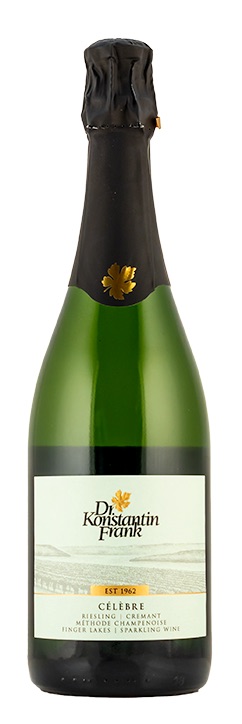 Classico have become so
hazy because of changes in the D.O.C.G. rules that
backing away to sample some of the bottlings from
the less well-known regions of Tuscany that make
Chianti is all to everybody’s benefit—especially
since Rufina itself is
now in the D.O.C.G. category. It’s made from
Sangiovese and other local varietals and is a label
with the famous Frescobaldi vintners umbrella. The
wine spends aging time in both barrels and bottle,
emerging at an ideal 13.5% alcohol to give it both
body and layers of peppery flavors characteristic of
Chianti.
Classico have become so
hazy because of changes in the D.O.C.G. rules that
backing away to sample some of the bottlings from
the less well-known regions of Tuscany that make
Chianti is all to everybody’s benefit—especially
since Rufina itself is
now in the D.O.C.G. category. It’s made from
Sangiovese and other local varietals and is a label
with the famous Frescobaldi vintners umbrella. The
wine spends aging time in both barrels and bottle,
emerging at an ideal 13.5% alcohol to give it both
body and layers of peppery flavors characteristic of
Chianti.
DR.
KONSTANTIN FRANK CÉLEBRÉ RIESLING CREMANTE ($25)—Dr.
Konstantin Frank has been an innovator for many
decades in New York’s Finger Lakes and this superb
100% Riesling displays the tantalizing quality of
this tangy varietal. The grapes are very lightly
pressed, with the secondary fermentation taking
place in bottle for a minimum of 24 months. The
slight sweetness is very appealing, as you’d find
in first-rate Trocken German Rieslings. It’s good
for a feast, not least with shellfish, fishes like
salmon and blue-veined cheeses.
❖❖❖
 BLOCK
THAT METAPHOR!
BLOCK
THAT METAPHOR!
"One of Mr. Torrisi’s gifts is his ability to let
you taste two ideas at once, as if he were playing a
harmonic line under the melody. Some of his dishes
remind me of Brian Wilson’s songs. They can have a
gentle, lyrical and introspective feeling while
showing a remarkable grasp of techniques that can be
used to achieve new effects. (Mr. Carbone, in this
scenario, is Mike Love, or at least his positive
traits; the restaurant that most clearly bears his
imprint, Carbone, is a master class in manipulating
the appeal of shared memories, good times and fun,
fun, fun.)." Pete Wells, NY Times (3/1/23)
❖❖❖
Any of John Mariani's books below may be ordered from amazon.com.
 The Hound in Heaven
(21st Century Lion Books) is a novella, and
for anyone who loves dogs, Christmas, romance,
inspiration, even the supernatural, I hope you'll find
this to be a treasured favorite. The story
concerns how, after a New England teacher, his wife and
their two daughters adopt a stray puppy found in their
barn in northern Maine, their lives seem full of promise.
But when tragedy strikes, their wonderful dog Lazarus and
the spirit of Christmas are the only things that may bring
his master back from the edge of despair.
The Hound in Heaven
(21st Century Lion Books) is a novella, and
for anyone who loves dogs, Christmas, romance,
inspiration, even the supernatural, I hope you'll find
this to be a treasured favorite. The story
concerns how, after a New England teacher, his wife and
their two daughters adopt a stray puppy found in their
barn in northern Maine, their lives seem full of promise.
But when tragedy strikes, their wonderful dog Lazarus and
the spirit of Christmas are the only things that may bring
his master back from the edge of despair. WATCH THE VIDEO!
“What a huge surprise turn this story took! I was completely stunned! I truly enjoyed this book and its message.” – Actress Ali MacGraw
“He had me at Page One. The amount of heart, human insight, soul searching, and deft literary strength that John Mariani pours into this airtight novella is vertigo-inducing. Perhaps ‘wow’ would be the best comment.” – James Dalessandro, author of Bohemian Heart and 1906.
“John Mariani’s Hound in Heaven starts with a well-painted portrayal of an American family, along with the requisite dog. A surprise event flips the action of the novel and captures us for a voyage leading to a hopeful and heart-warming message. A page turning, one sitting read, it’s the perfect antidote for the winter and promotion of holiday celebration.” – Ann Pearlman, author of The Christmas Cookie Club and A Gift for my Sister.
“John Mariani’s concise, achingly beautiful novella pulls a literary rabbit out of a hat – a mash-up of the cosmic and the intimate, the tragic and the heart-warming – a Christmas tale for all ages, and all faiths. Read it to your children, read it to yourself… but read it. Early and often. Highly recommended.” – Jay Bonansinga, New York Times bestselling author of Pinkerton’s War, The Sinking of The Eastland, and The Walking Dead: The Road To Woodbury.
“Amazing things happen when you open your heart to an animal. The Hound in Heaven delivers a powerful story of healing that is forged in the spiritual relationship between a man and his best friend. The book brings a message of hope that can enrich our images of family, love, and loss.” – Dr. Barbara Royal, author of The Royal Treatment.
 |
The Encyclopedia of American Food and Drink by John F. Mariani (Bloomsbury USA, $35) Modesty forbids me to praise my own new book, but let me proudly say that it is an extensive revision of the 4th edition that appeared more than a decade ago, before locavores, molecular cuisine, modernist cuisine, the Food Network and so much more, now included. Word origins have been completely updated, as have per capita consumption and production stats. Most important, for the first time since publication in the 1980s, the book includes more than 100 biographies of Americans who have changed the way we cook, eat and drink -- from Fannie Farmer and Julia Child to Robert Mondavi and Thomas Keller. "This book is amazing! It has entries for everything from `abalone' to `zwieback,' plus more than 500 recipes for classic American dishes and drinks."--Devra First, The Boston Globe. "Much needed in any kitchen library."--Bon Appetit. |
"Eating Italian will never be the same after reading John Mariani's entertaining and savory gastronomical history of the cuisine of Italy and how it won over appetites worldwide. . . . This book is such a tasteful narrative that it will literally make you hungry for Italian food and arouse your appetite for gastronomical history."--Don Oldenburg, USA Today. "Italian
restaurants--some good, some glitzy--far
outnumber their French rivals. Many of
these establishments are zestfully described
in How Italian Food Conquered the World, an
entertaining and fact-filled chronicle by
food-and-wine correspondent John F.
Mariani."--Aram Bakshian Jr., Wall Street
Journal.
"Equal parts
history, sociology, gastronomy, and just
plain fun, How Italian Food Conquered the
World tells the captivating and delicious
story of the (let's face it) everybody's
favorite cuisine with clarity, verve and
more than one surprise."--Colman Andrews,
editorial director of The Daily
Meal.com. "A fantastic and fascinating
read, covering everything from the influence
of Venice's spice trade to the impact of
Italian immigrants in America and the
evolution of alta cucina. This book will
serve as a terrific resource to anyone
interested in the real story of Italian
food."--Mary Ann Esposito, host of PBS-TV's
Ciao
Italia. "John Mariani has written the
definitive history of how Italians won their
way into our hearts, minds, and
stomachs. It's a story of pleasure over
pomp and taste over technique."--Danny Meyer,
owner of NYC restaurants Union Square
Cafe, The Modern, and Maialino.
|
 |
 |
 |
 |
 |
 |
MARIANI'S VIRTUAL GOURMET
NEWSLETTER is published weekly. Publisher: John Mariani. Editor: Walter Bagley. Contributing Writers: Christopher
Mariani, Misha Mariani, John A. Curtas, Gerry Dawes, Geoff Kalish.
Contributing
Photographer: Galina Dargery. Technical
Advisor: Gerry
McLoughlin.
If you wish to subscribe to this
newsletter, please click here: http://www.johnmariani.com/subscribe/index.html
© copyright John Mariani 2023
